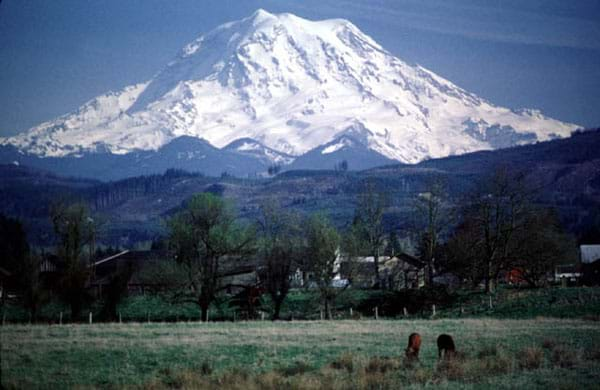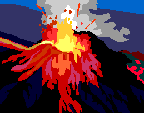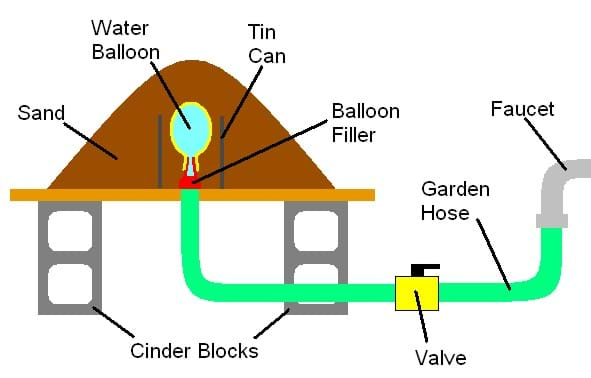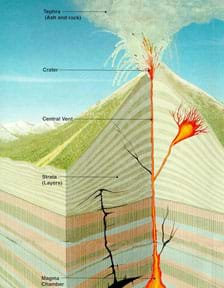Quick Look
Grade Level: 5 (3-5)
Time Required: 45 minutes
Expendable Cost/Group: US $1.00
Group Size: 1
Activity Dependency: None
Subject Areas: Earth and Space

Summary
Students observe an in-classroom visual representation of a volcanic eruption. The water-powered volcano demonstration is made in advance, using sand, hoses and a water balloon, representing the main components of all volcanoes. During the activity, students observe, measure and sketch the volcano, seeing how its behavior provides engineers with indicators used to predict an eruption.Engineering Connection
Even though we cannot prevent volcanic eruptions, there are telltale signs that an eruption is going to occur. Engineers design and build devices to detect indications of an impending eruption. One sign is a swelling of the mountain as the magma chamber fills. Engineers use tilt meters and surveying techniques to watch and measure this swelling, so that people near the volcano can be safely evacuated in advance of the blast.
Learning Objectives
After this activity, students should be able to:
- Identify several elements of a volcano.
- Explain that sometimes a volcano rises as the magma chamber fills prior to an eruption.
- Describe how engineers create devices that can predict future eruptions.
Educational Standards
Each TeachEngineering lesson or activity is correlated to one or more K-12 science,
technology, engineering or math (STEM) educational standards.
All 100,000+ K-12 STEM standards covered in TeachEngineering are collected, maintained and packaged by the Achievement Standards Network (ASN),
a project of D2L (www.achievementstandards.org).
In the ASN, standards are hierarchically structured: first by source; e.g., by state; within source by type; e.g., science or mathematics;
within type by subtype, then by grade, etc.
Each TeachEngineering lesson or activity is correlated to one or more K-12 science, technology, engineering or math (STEM) educational standards.
All 100,000+ K-12 STEM standards covered in TeachEngineering are collected, maintained and packaged by the Achievement Standards Network (ASN), a project of D2L (www.achievementstandards.org).
In the ASN, standards are hierarchically structured: first by source; e.g., by state; within source by type; e.g., science or mathematics; within type by subtype, then by grade, etc.
NGSS: Next Generation Science Standards - Science
-
A system can be described in terms of its components and their interactions.
(Grades 3 - 5)
More Details
Do you agree with this alignment?
-
A variety of hazards result from natural processes (e.g., earthquakes, tsunamis, volcanic eruptions). Humans cannot eliminate the hazards but can take steps to reduce their impacts.
(Grade 4)
More Details
Do you agree with this alignment?
-
Science explanations describe the mechanisms for natural events.
(Grade 5)
More Details
Do you agree with this alignment?
International Technology and Engineering Educators Association - Technology
-
The process of experimentation, which is common in science, can also be used to solve technological problems.
(Grades
3 -
5)
More Details
Do you agree with this alignment?
State Standards
Colorado - Science
-
Analyze and interpret data identifying ways Earth's surface is constantly changing through a variety of processes and forces such as plate tectonics, erosion, deposition, solar influences, climate, and human activity
(Grade
5)
More Details
Do you agree with this alignment?
-
Develop and communicate an evidence based scientific explanation around one or more factors that change Earth's surface
(Grade
5)
More Details
Do you agree with this alignment?
Materials List
Each student needs:
To share with the entire class:
- 4 cinder blocks or other similarly-shaped object that can support 30 pounds • 1 wooden board, ~2 ft x 2 ft (~.6 x .6 m)
- Drill, to make a hole in the center of the board, just big enough for a garden hose to fit through, 1.1-inch – 1.2-inch (2.8 - 3 cm) diameter
- 4 strips of wood (optional) to place around the edge of the board to create a low box; the strips help to contain the sand during eruption
- Sand, 30-50 lbs (14 -23 kg)
- 1 bag of water balloons (available at toy and party stores)
- 1 water balloon filler attachment for a hose (usually comes in a bag of water balloons or purchased separately)
- 1 metal can with the top and bottom cut off
- 2 lengths of garden hose (anywhere between 4 to 100 feet [1.2 - 30 m] each)
- 1 garden hose valve
- Several small rubber bands
- 1 ruler or tape measure
Worksheets and Attachments
Visit [www.teachengineering.org/activities/view/cub_natdis_lesson04_activity1] to print or download.Introduction/Motivation
A volcano has many parts. How many parts of a volcano can you name? Under the volcano is a compartment of molten (melted) rock known as the magma chamber. This molten rock or magma travels from the magma chamber up through the crust of the Earth through a crack known as a vent. Hot magma exits the volcano at the crater, becoming lava. If the eruption is violent, then ash, rock and lava are launched into the air, collecting on the sides of the volcano. After many eruptions the layers of ash, rock and solidified lava build up to form the recognizable cone shape of a volcano. On the top of the cone is the crater, or indentation in the volcano that marks where past eruptions have occurred.
Volcanoes are natural events in the life of our planet. Can we prevent volcanoes? The answer is no. They are extremely powerful forces of nature that we have no control over. So, what can we do about volcanoes? Well, we can try to predict when a volcano will erupt. While we cannot perfectly predict every eruption, scientists and engineers look for some common signs that indicate an eruption is coming. These include gas emissions, earthquakes and a growth of the mountain. That's right; the mountain actually grows prior to an eruption!

Why do you think a volcano grows before it erupts? The reason is that the magma chamber fills with magma. The magma chamber acts like a balloon filling with air. As more magma comes into the magma chamber from the center of the Earth, it expands and builds up pressure. The expanding magma chamber pushes up the rock and earth above the chamber, causing the volcano to grow. Eventually, the pressure is too great and the magma escapes to the surface as hot liquid lava. When this happens, the magma chamber shrinks and the mountain shrinks in turn.
So, how do you think engineers help us to detect volcano eruptions? Well, engineers look for this growth as a way to predict when a volcano is about to erupt. They create measurement devices, like a tilt meter (see lesson 3: Volcanic Panic!) that record changes in height or movement of the land around a volcano. Using these instruments, engineers help us find out when a volcano is active or going to erupt. Today, we are going to watch a volcano in action. Maybe you can be engineers and help us figure out when it will erupt!
Procedure
Before the Activity
- Gather materials. Build and test the demonstration volcano (see instructions, below).
- Make copies of the Excellent Eruption Worksheet, one per student.
Build the Demonstration Volcano
- Construct the demonstration volcano outside when students are not around, so they do not learn what is inside the volcano until it erupts.
- Begin by drilling a hole in the center of the wooden board. Make the hole between 1.1-inch to 1.2-inch (2.8 - 3 cm) in diameter, just big enough for a garden hose to fit through.
- (optional) It is recommended, but not necessary, to place a strip of wood around the edge of the board to create a low box; this helps to contain the sand during eruption.
- Place the board on the cinder blocks so that it is elevated off the ground (see Figure 1).

- Place one of the hoses through the hole in the board and screw the water balloon filler onto the end. Pull the hose back through the hole until the filler is resting vertically on the board.
- Attach the other end of the hose to a valve and attach the valve to a faucet via the second hose.
- Run water through the hoses to remove all the air from them.
- Place a water balloon over the filler tip and secure with a rubber band.
- Place the metal can around the water balloon and place sand in the can until it is filled up to balloon.
- Turn the valve on slightly to allow a small amount of water to flow into the water balloon. Fill up the balloon until the top of the balloon is just over the edge of the tin can.
- Wet the sand and build up a hill around the can and over the balloon. Place at least 5 cm (2 inches) of sand above the balloon.
- The volcano is now ready to erupt!
With the Students
- With the class gathered around the volcano demonstration, review the parts of a volcano (vent, crater, cone, magma, lava, magma chamber).
- Hand out the worksheets and have students draw the volcano on the first page.
- Give two students a ruler (or tape measure) and have them measure the height of the volcano before the eruption. Have students record the height on their worksheet.
- Ask the students to watch the volcano closely. Then, open the valve slightly, so that the top of the volcano rises slightly; then close the valve.
- Have the students answer the question on their worksheets, "What changed about the volcano?" Then, ask them why this is happening. Have them respond in terms of a real volcano. If they do not know, lead them to the idea that before an eruption, more magma flows into the magma chamber, which pushes the earth above the chamber, causing it to move upwards. In our demonstration, magma is represented by water and the magma chamber is represented by the balloon.
- Give two different students the ruler and have them measure the height of the volcano again. Have the students record the height on their worksheet.
- Open the valve slightly again and let the balloon fill until it bursts. Then, open the valve a little more until water shoots out of the volcano a few inches. Allow the water to flow for a few seconds and then turn the water off.

- On their worksheets, have students draw the volcano as it looks now, after the eruption. There should be a crater at the peak.
- Give two different students the ruler and have them measure the height of the volcano again. Have the students record the height on their worksheet.
- Have them answer the question on their worksheet, "What happened to the volcano during the eruption?" Then ask them why this happened. Have them answer in terms of the demonstration as well as a real volcano. They should come to the conclusion that pressure builds in the magma chamber until the volcano can no longer contain the magma. At this point the volcano erupts and the magma becomes lava.
- Have the students complete the worksheet.
- Lead a class discussion. What are signs that a volcano is active or going to erupt? How did our measurement of the mountain height change from the first to second to third measurements? Why did the mountain grow? Why did a crater form? What will be the starting height if the volcano were to blow again? How do engineers help us find out when a volcano will erupt? Conduct the activities described in the Assessment section.
- Finally, have the students draw and decorate their own cut-away diagram of a volcano (see Figure 2), labeling the major parts: cone, vent, magma, magma chamber, tephra, lava and crater.
Vocabulary/Definitions
cone: The body of a volcano, in the shape of a cone. The crater is typically located at the top of the cone.
crater: A bowl-shaped opening at the top of a volcano. This is typically where tephra and lava escape from the volcano.
detect: To discover or find the existence of something.
eruption: The act of forcing out or releasing something, such as steam or magma, with violence or suddenness.
lava: Magma that has reached the surface of the Earth.
magma: Molten rock.
magma chamber: A chamber below the Earth's surface that contains a large quantity of magma.
molten: Made liquid by heat; melted.
tephra: Any solid material ejected into the atmosphere from a volcanic eruption.
tilt meter: An instrument that detects slight changes in the shape of a structure or mountain.
vent: An opening permitting the escape of fumes, a liquid, a gas or steam.
volcano: An opening in the Earth's crust through which molten lava, ash and gases are ejected.
Assessment
Pre-Activity Assessment
Brainstorming: Have students engage in open discussion about volcanoes. Remind students that no idea or suggestion is "silly." All ideas should be respectfully heard. Ask the students:
- Why does a volcano erupt?
- What happens to cause an eruption?
Activity Embedded Assessment
Discussion Questions: Solicit, integrate and summarize student responses. Ask the students:
- Before the eruption: What are signs that a volcano is active or going to erupt? (Possible answers: Earthquakes, gases escaping, the mountain growing.)
- After the mountain has risen: Why do you think the mountain grew? (Answer: Magma is moving into and filling up the magma chamber, pushing the mountain upward.)
- After the eruption: Why did a crater form? (Answer: After the magma escaped from the magma chamber, the chamber collapsed, forming the crater.)
- After the eruption: How can an engineer help us find out when a volcano will erupt? (Answer: Engineers design instruments that take measurements of the height of a volcano and the movement of the ground around the volcano.)
Worksheet: Have students record their observations on the activity worksheet; review their answers to gauge their mastery of the subject.
Post-Activity Assessment
Explaining the Model: Set up the volcano apparatus again, so students can see what is inside. Then, have it erupt again. Ask the students to identify what the following parts of the demonstration volcano represent on an actual volcano:
- Water balloon (represents magma chamber)
- Water (represents hot liquid magma and lava)
- Sand (represents volcano cone)
Student-Generated Definitions: Have students come up with class definitions for the following terms and write them on the board.
- Cone (Definition: The body of the volcano that is made up of layers of tephra [ash and rock that was launched into the air] and solidified lava.)
- Crater (Definition: The depression located at the top of the cone that marks where past eruptions have occurred.)
- Magma (Definition: Molten [melted] rock located under the surface of the Earth.)
- Lava (Definition: Magma, once it has reached the surface. In a hot, liquid form.)
- Vent (Definition: The fissure or crack in the Earth's surface that the magma travels through to get to the Earth's surface.)
- Magma chamber (Definition: An underground chamber filled with magma.)
Safety Issues
- Prior to the volcano eruption, have students stand back at least two meters (five feet) from the volcano so they do not get sand in their eyes.
Troubleshooting Tips
Test and experiment with the volcano apparatus before demonstrating it to the students. It takes a little practice to give the water balloon just enough water.
Activity Extensions
Have student work in teams as engineers. Assign each team to build a device that can detect the eruption of the demonstration water volcano. Set up the volcano and have the students place their device on/near the volcano and see if they can predict the eruption.
Have students research famous volcanoes to find out if there was any warning of an eruption.
Subscribe
Get the inside scoop on all things TeachEngineering such as new site features, curriculum updates, video releases, and more by signing up for our newsletter!More Curriculum Like This

Students learn about the causes, composition and types of volcanoes. They begin with an overview of the Earth's interior and how volcanoes form. Once students know how volcanoes function, they learn how engineers predict eruptions.

Students learn about the underlying factors that can contribute to Plinian eruptions (which eject large amounts of pumice, gas and volcanic ash, and can result in significant death and destruction in the surrounding environment), versus more gentle, effusive eruptions. They experiment with three fl...

While learning about volcanoes, magma and lava flows, students learn about the properties of liquid movement, coming to understand viscosity and other factors that increase and decrease liquid flow. They also learn about lava composition and its risk to human settlements.

Students are introduced to natural disasters and learn the difference between natural hazards and natural disasters.
References
Dictionary.com. Lexico Publishing Group, LLC. Accessed February 8, 2006. (Source of some vocabulary definitions, with some adaptation) http://www.dictionary.com
Tilling, Robert I. Monitoring Active Volcanoes. Last updated April 30, 1999. U.S. Geological Survey, U.S. Department of the Interior. Accessed February 8, 2006. http://pubs.usgs.gov/gip/monitor/contents.html
Copyright
© 2006 by Regents of the University of Colorado.Contributors
Geoffrey Hill; Malinda Schaefer Zarske; Denise W. CarlsonSupporting Program
Integrated Teaching and Learning Program, College of Engineering, University of Colorado BoulderAcknowledgements
The contents of this digital library curriculum were developed under a grant from the Fund for the Improvement of Postsecondary Education (FIPSE), U.S. Department of Education, and National Science Foundation GK-12 grant no 0338326. However, these contents do not necessarily represent the policies of the Department of Education or National Science Foundation, and you should not assume endorsement by the federal government.
Last modified: May 7, 2019









User Comments & Tips